A Study on the Microstructure and Mechanical Properties of Improved 25Ni-20Cr Steel via in Situ Testing
Abstract
1. Introduction
2. Materials and Methods
3. Results and Discussion
3.1. Microstructures Characterization
3.2. Compression Properties
3.3. Tensile Properties and Microstructure
4. Conclusions
- (1)
- By the regulation of microalloying elements in S35140 steel, new strengthening phases M(C, N), MC, MN and Ti(C, N) were precipitated, which compensated for the loss of high-temperature strength after a significant reduction in carbon content. Typically, there is a positive effect of the precipitates distributed along the grain boundaries on the mechanical properties of NS steels. Improved N-S35140 steel has numerous precipitated phases distributed both within the grains and at the grain boundaries. In addition, planar twinning dislocations were observed inside the crystals.
- (2)
- The compressive yield strength of N-S35140 steel during TEM in situ compression at room temperature is 618.4 MPa, which is significantly higher than the compressive yield strength of AISI 304L stainless steel. N-S35140 steel, with its higher compressive yield strength, demonstrates superior shape and dimensional stability compared to AISI 304L stainless steel under load. At room temperature, the tensile strength of N-S35140 steel is 638.5 MPa, with a yield strength of 392.8 MPa and an elongation of 32.7%, which surpasses those of S35140 steel at room temperature. During SEM in situ tensile testing at 350 °C, N-S35140 steel exhibits a tensile strength of 481.7 MPa, a yield strength of 234.9 MPa, and an elongation of 66.5%. When the testing temperature is increased to 650 °C, the tensile strength decreases to 330.6 MPa, with a yield strength of 228.2 MPa and an elongation of 51.4%. The yield strength and elongation of N-S35140 steel are superior to those of Alloy 709 steel and AISI 316L at elevated temperatures.
- (3)
- The grains from the IPF map have deformed along the tensile direction, with twins still present after tensile fracture at 350 °C. Significant grain deformation along the tensile direction is further evident after tensile fracture at 650 °C. Numerous small dimples are observed after SEM in situ tensile testing at room temperature, indicating a typical ductile fracture mechanism. As the testing temperature increases to 350 °C (Figure 10b) and 650 °C (Figure 10c), the dimples become larger, deeper, and less densely distributed. N-S35140 steel exhibits better plasticity at high temperatures compared to room temperature.
Author Contributions
Funding
Data Availability Statement
Acknowledgments
Conflicts of Interest
References
- Porter, T.; Findley, K.; McMurtrey, M. Assessment of creep-fatigue behavior of alloy 709. Trans. Am. Nucl. Soc. 2017, 117, 559–562. [Google Scholar]
- Lall, A.; Bowen, P.; Rabiei, A. A study on the creep behavior of alloy 709 using in-situ scanning electron microscopy. Mater. Charact. 2022, 183, 111587. [Google Scholar] [CrossRef]
- Zhao, Y.; Schoell, R.; Zheng, C.; Cinbiz, M.N.; Frost, M.; An, K.; Kaoumi, D. Creep properties of advanced austenitic steel 709 determined through short experiments under in-situ neutron diffraction followed by TEM characterization. Mater. Charact. 2021, 182, 111519. [Google Scholar] [CrossRef]
- Alsmadi, Z.Y.; Alomari, A.; Kumar, N.; Murty, K. Effect of hold time on high temperature creep-fatigue behavior of Fe–25Ni–20Cr (wt.%) austenitic stainless steel (Alloy 709). Mater. Sci. Eng. A 2020, 771, 138591. [Google Scholar] [CrossRef]
- Sourmail, T. Precipitation in creep resistant austenitic stainless steels. Mater. Sci. Technol. 2001, 17, 1–14. [Google Scholar] [CrossRef]
- Kruizenga, A.M.; Gill, D.D.; LaFord, M.E. Materials Corrosion of High Temperature Alloys Immersed in 600C Binary Nitrate Salt; Sandia National Lab. (SNL-CA): Livermore, CA, USA, 2013. [Google Scholar]
- Lv, X.; Chen, S.; Wang, Q.; Jiang, H.; Rong, L. Temperature dependence of fracture behavior and mechanical properties of AISI 316 austenitic stainless steel. Metals 2022, 12, 1421. [Google Scholar] [CrossRef]
- Zhou, P.; Yang, W.; Wu, Y.; Zong, Y. Characterization of microstructural evolution with pre-strain in BG801 bearing steel: Grain, carbides, retained austenite and martensite. Vacuum 2023, 216, 112354. [Google Scholar] [CrossRef]
- Ren, W.; Wang, L. Precipitation behavior of M23C6 in high nitrogen austenitic heat-resistant steel. J. Alloys Compd. 2022, 905, 164013. [Google Scholar] [CrossRef]
- Jiao, S.; Zhang, M.; Zheng, L.; Dong, J. Investigation of carbide precipitation process and chromium depletion during thermal treatment of Alloy 690. Metall. Mater. Trans. A 2010, 41, 26–42. [Google Scholar] [CrossRef]
- Sahlaoui, H.; Makhlouf, K.; Sidhom, H.; Philibert, J. Effects of ageing conditions on the precipitates evolution, chromium depletion and intergranular corrosion susceptibility of AISI 316L: Experimental and modeling results. Mater. Sci. Eng. A 2004, 372, 98–108. [Google Scholar] [CrossRef]
- Pint, B.A.; Peraldi, R.; Maziasz, P.J. The use of model alloys to develop corrosion-resistant stainless steels. In Proceedings of the Materials Science Forum, Les Embiez, France, 16–21 May 2004; pp. 815–822. [Google Scholar]
- Opila, E.J. Volatility of common protective oxides in high-temperature water vapor: Current understanding and unanswered questions. In Proceedings of the Materials Science Forum, Les Embiez, France, 16–21 May 2004; pp. 765–774. [Google Scholar]
- Viswanathan, R.; Bakker, W. Materials for ultrasupercritical coal power plants—Turbine materials: Part II. J. Mater. Eng. Perform. 2001, 10, 96–101. [Google Scholar] [CrossRef]
- Viswanathan, R.; Coleman, K.; Rao, U. Materials for ultra-supercritical coal-fired power plant boilers. Int. J. Press. Vessel. Pip. 2006, 83, 778–783. [Google Scholar] [CrossRef]
- Yang, T.-X.; Li, Z.-X.; Zhou, C.-J.; Xu, Y.-C.; Dou, P. Effects of Zr and/or Ti addition on the morphology, crystal and metal/oxide interface structures of nanoparticles in FeCrAl-ODS steels. J. Nucl. Mater. 2023, 585, 154613. [Google Scholar] [CrossRef]
- Yan, X.; Li, Z.; Lei, P.; Wang, S.; Gao, R. Significant suppression of helium bubbles in oxide dispersion strengthened FeCrAl alloys irradiated by high concentration of helium. Vacuum 2024, 221, 112915. [Google Scholar] [CrossRef]
- Brady, M.P.; Magee, J.; Yamamoto, Y.; Helmick, D.; Wang, L. Co-optimization of wrought alumina-forming austenitic stainless steel composition ranges for high-temperature creep and oxidation/corrosion resistance. Mater. Sci. Eng. A 2014, 590, 101–115. [Google Scholar] [CrossRef]
- Brady, M.; Wright, I.; Gleeson, B. Alloy design strategies for promoting protective oxide-scale formation. Jom 2000, 52, 16–21. [Google Scholar] [CrossRef]
- Brady, M.P.; Yamamoto, Y.; Santella, M.L.; Pint, B.A. Effects of minor alloy additions and oxidation temperature on protective alumina scale formation in creep-resistant austenitic stainless steels. Scr. Mater. 2007, 57, 1117–1120. [Google Scholar] [CrossRef]
- Xu, X.; Zhang, X.; Chen, G.; Lu, Z. Improvement of high-temperature oxidation resistance and strength in alumina-forming austenitic stainless steels. Mater. Lett. 2011, 65, 3285–3288. [Google Scholar] [CrossRef]
- Sharifikolouei, E.; Sarac, B.; Micoulet, A.; Mager, R.; Watari-Alvarez, M.; Hadjixenophontos, E.; Burghard, Z.; Schmitz, G.; Spatz, J.P. Improvement of hardness in Ti-stabilized austenitic stainless steel. Mater. Des. 2022, 223, 111242. [Google Scholar] [CrossRef]
- Farahat, A.I.Z.; El-Bitar, T. Effect of Nb, Ti and cold deformation on microstructure and mechanical properties of austenitic stainless steels. Mater. Sci. Eng. A 2010, 527, 3662–3669. [Google Scholar] [CrossRef]
- Li, L.; Ding, Q.; Zhang, Z.; Li, Y.; Wei, X.; Zhang, Z.; Bei, H. The effect of Al and Ti on the microstructure, mechanical properties and oxidation resistance of γ′-Ni3 (Al, Ti) strengthened austenitic stainless steels. J. Mater. Res. Technol. 2023, 24, 4650–4660. [Google Scholar] [CrossRef]
- Inoue, Y.; Hiraide, N.; Hayashi, A.; Ushioda, K. Effect of titanium on oxidation behavior of high-purity ferritic stainless steel. Mater. Trans. 2019, 60, 1968–1976. [Google Scholar] [CrossRef]
- Pardo, A.; Merino, M.; Coy, A.; Viejo, F.; Carboneras, M.; Arrabal, R. Influence of Ti, C and N concentration on the intergranular corrosion behaviour of AISI 316Ti and 321 stainless steels. Acta Mater. 2007, 55, 2239–2251. [Google Scholar] [CrossRef]
- Qi, W.; Guoshuai, C.; Zhangjian, Z.; Ru, X.; Jiyun, Z.; Rui, T.; Lefu, Z. Effect of N and Al Addition on Microstructure and Mechanical Properties of Modified 25Ni-20Cr Austenitic Stainless Steel Aged at 700 °C. Nucl. Power Eng. 2023, 44, 275–283. [Google Scholar]
- Morales, M.; Rezayat, M.; García-González, S.; Mateo, A.; Jiménez-Piqué, E. Ru-Ce0.7Zr0.3O2−δ as an anode catalyst for the internal reforming of dimethyl ether in solid oxide fuel cells. Nanomaterials 2024, 14, 603. [Google Scholar] [CrossRef]
- Taneike, M.; Abe, F.; Sawada, K. Creep-strengthening of steel at high temperatures using nano-sized carbonitride dispersions. Nature 2003, 424, 294–296. [Google Scholar] [CrossRef] [PubMed]
- Hu, J.; Xiao, Z.; Huang, Y. Segregation of solute elements and their effects on the strength of Al Σ5 (210) [001] symmetrical tilt grain boundary in 2219 alloys. Mater. Sci. Eng. A 2021, 800, 140261. [Google Scholar] [CrossRef]
- Peng, H.; Huo, W.; Zhang, W.; Tang, Y.; Zhang, S.; Huang, L.; Hou, H.; Ding, Z.; Liu, F. Correlation between stabilizing and strengthening effects due to grain boundary segregation in iron-based alloys: Theoretical models and first-principles calculations. Acta Mater. 2023, 251, 118899. [Google Scholar] [CrossRef]
- Li, D.; Feng, Y.; Song, S.; Liu, Q.; Bai, Q.; Wu, G.; Lv, N.; Ren, F. Influences of Nb-microalloying on microstructure and mechanical properties of Fe–25Mn–3Si–3Al TWIP steel. Mater. Des. 2015, 84, 238–244. [Google Scholar] [CrossRef]
- Wang, H.; Du, H.; Wei, Y.; Hou, L.; Liu, X.; Wei, H.; Liu, B.; Jia, J. Precipitation and properties at elevated temperature in austenitic heat-resistant steels—A review. Steel Res. Int. 2021, 92, 2000378. [Google Scholar] [CrossRef]
- Qu, S.; Huang, C.; Gao, Y.; Yang, G.; Wu, S.; Zang, Q.; Zhang, Z. Tensile and compressive properties of AISI 304L stainless steel subjected to equal channel angular pressing. Mater. Sci. Eng. A 2008, 475, 207–216. [Google Scholar] [CrossRef]
- Uchic, M.D.; Dimiduk, D.M.; Florando, J.N.; Nix, W.D. Sample dimensions influence strength and crystal plasticity. Science 2004, 305, 986–989. [Google Scholar] [CrossRef]
- A240/A240M-19; Standard Specification for Chromium and Chromium-Nickel Stainless Steel Plate, Sheet, and Strip for Pressure Vessels and for General Applications. ASTM International: West Conshohocken, PA, USA, 2019.
- Calmunger, M.; Chai, G.; Eriksson, R.; Johansson, S.; Moverare, J.J. Characterization of austenitic stainless steels deformed at elevated temperature. Metall. Mater. Trans. A 2017, 48, 4525–4538. [Google Scholar] [CrossRef]
- Zhao, Y.; Cinbiz, M.N.; Park, J.-S.; Almer, J.; Kaoumi, D. Tensile behavior and microstructural evolution of a Fe-25Ni-20Cr austenitic stainless steel (alloy 709) from room to elevated temperatures through in-situ synchrotron X-ray diffraction characterization and transmission electron microscopy. J. Nucl. Mater. 2020, 540, 152367. [Google Scholar] [CrossRef]
- Saenarjhan, N.; Kang, J.-H.; Kim, S.-J. Effects of carbon and nitrogen on austenite stability and tensile deformation behavior of 15Cr-15Mn-4Ni based austenitic stainless steels. Mater. Sci. Eng. A 2019, 742, 608–616. [Google Scholar] [CrossRef]
- Shim, J.-H.; Kozeschnik, E.; Jung, W.-S.; Lee, S.-C.; Kim, D.-I.; Suh, J.-Y.; Lee, Y.-S.; Cho, Y.W. Numerical simulation of long-term precipitate evolution in austenitic heat-resistant steels. Calphad 2010, 34, 105–112. [Google Scholar] [CrossRef]
- Kumar, B.R.; Mahato, B.; Bandyopadhyay, N.; Bhattacharya, D.K. Comparison of rolling texture in low and medium stacking fault energy austenitic stainless steels. Mater. Sci. Eng. A 2005, 394, 296–301. [Google Scholar] [CrossRef]
- Das, A.; Tarafder, S. Experimental investigation on martensitic transformation and fracture morphologies of austenitic stainless steel. Int. J. Plast. 2009, 25, 2222–2247. [Google Scholar] [CrossRef]

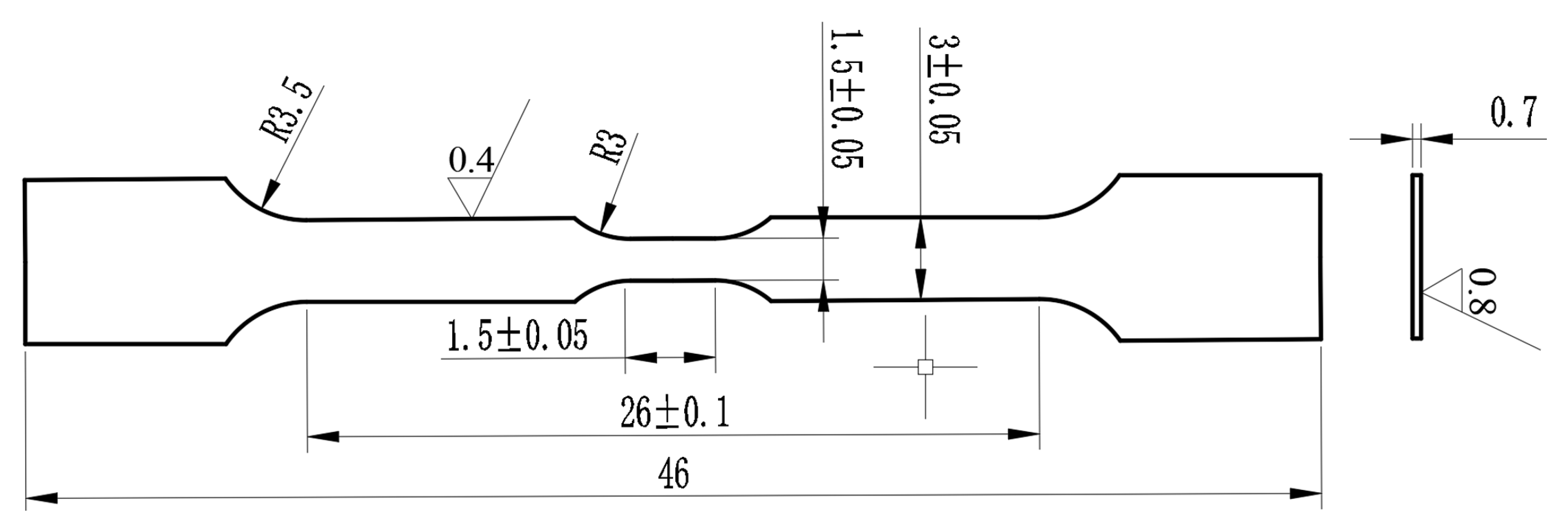

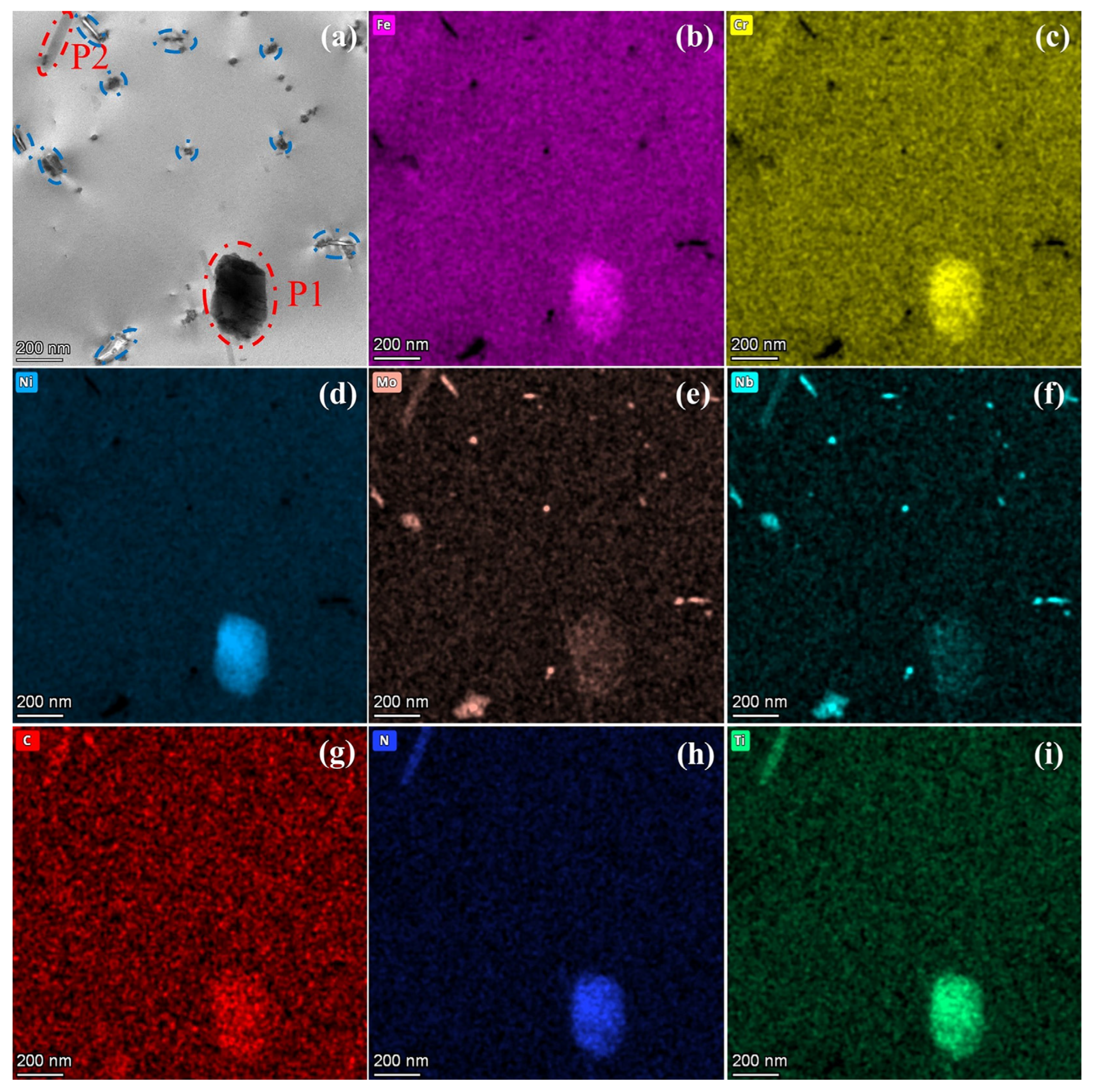
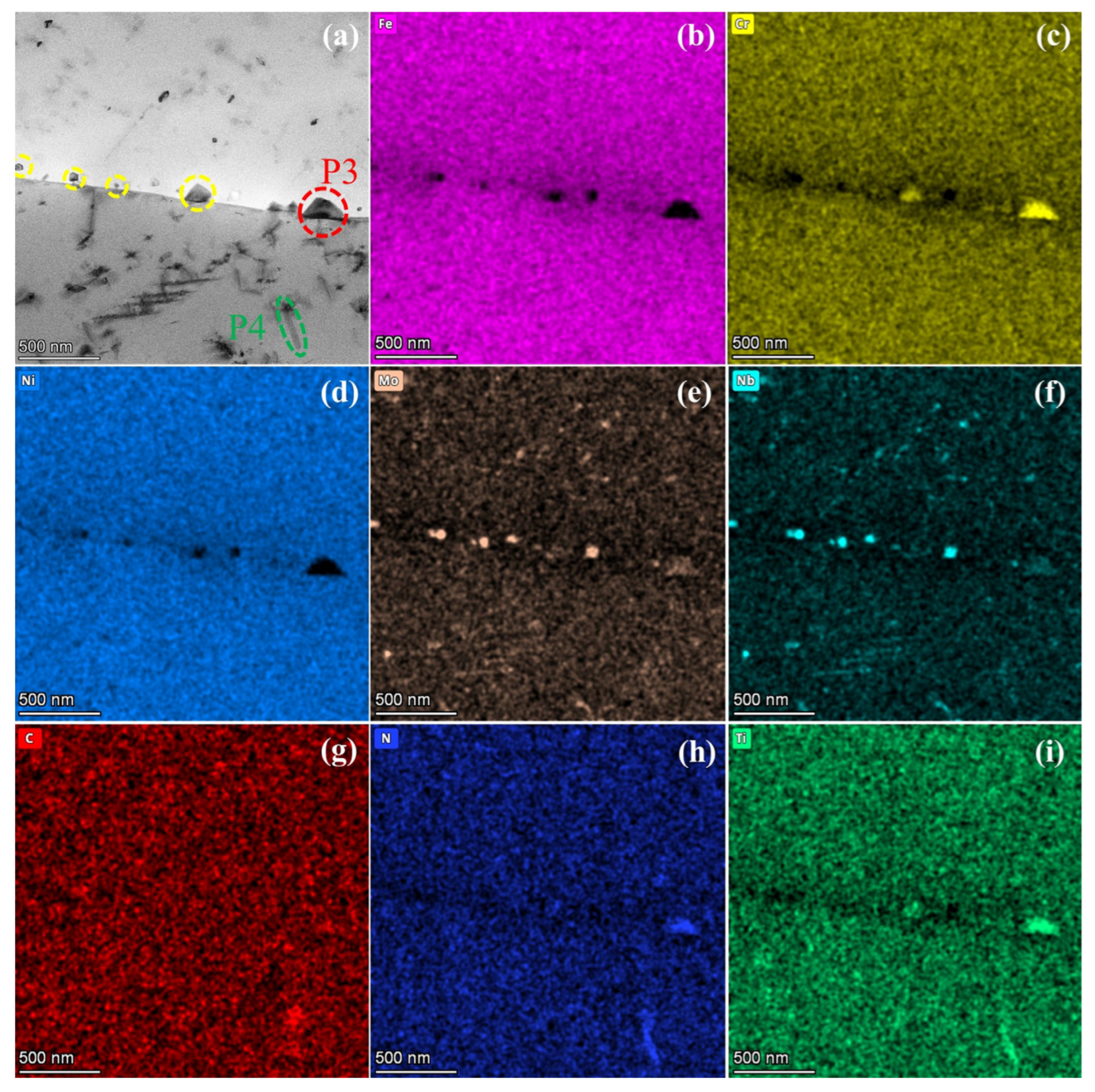
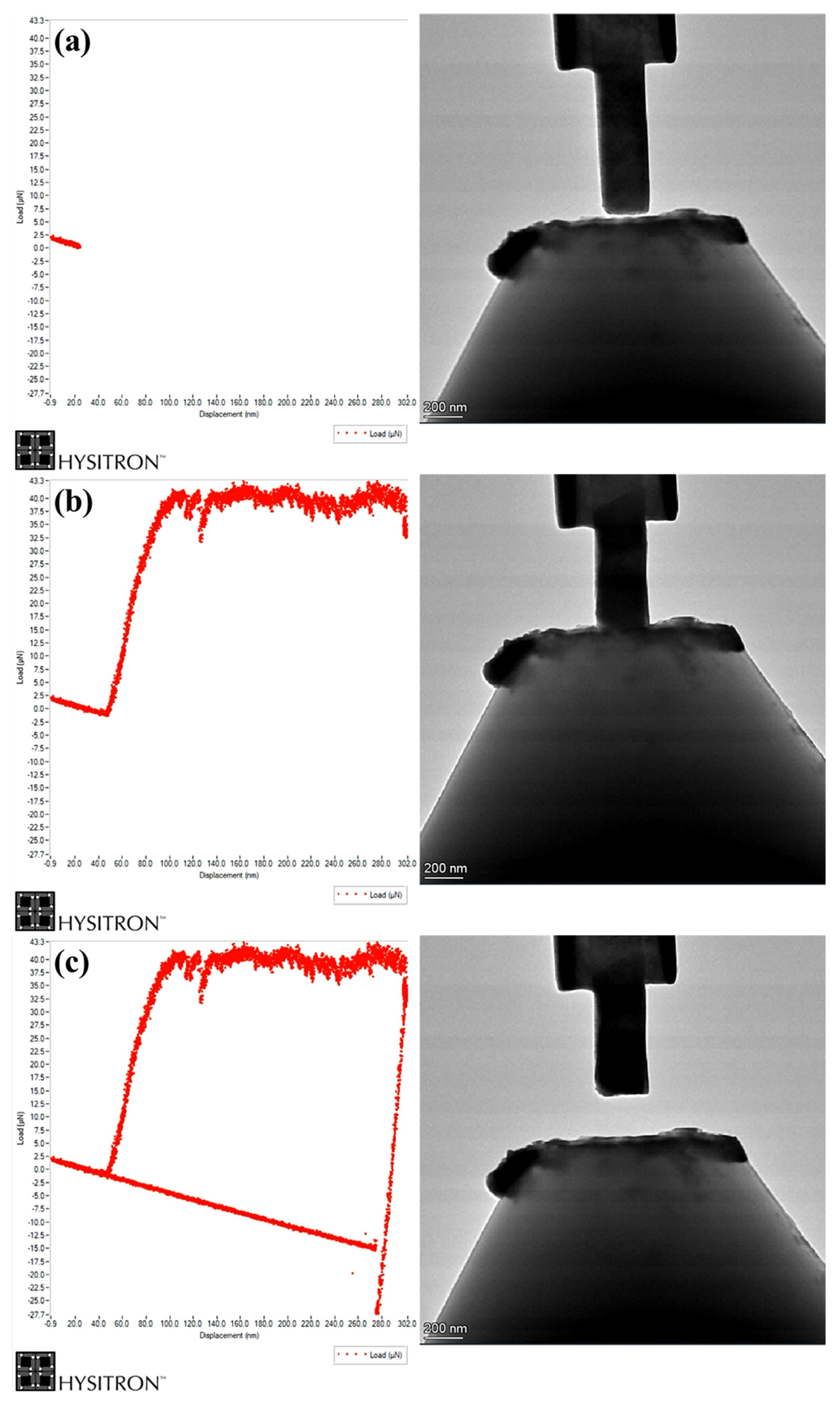

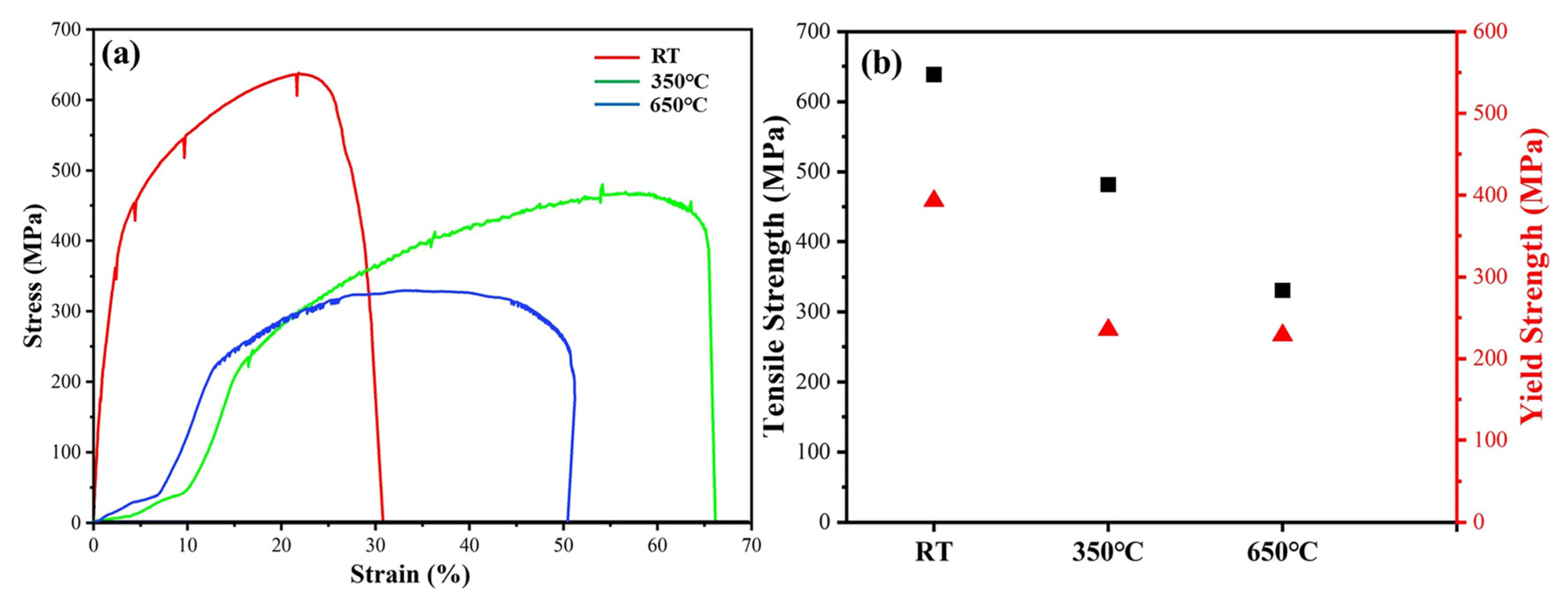
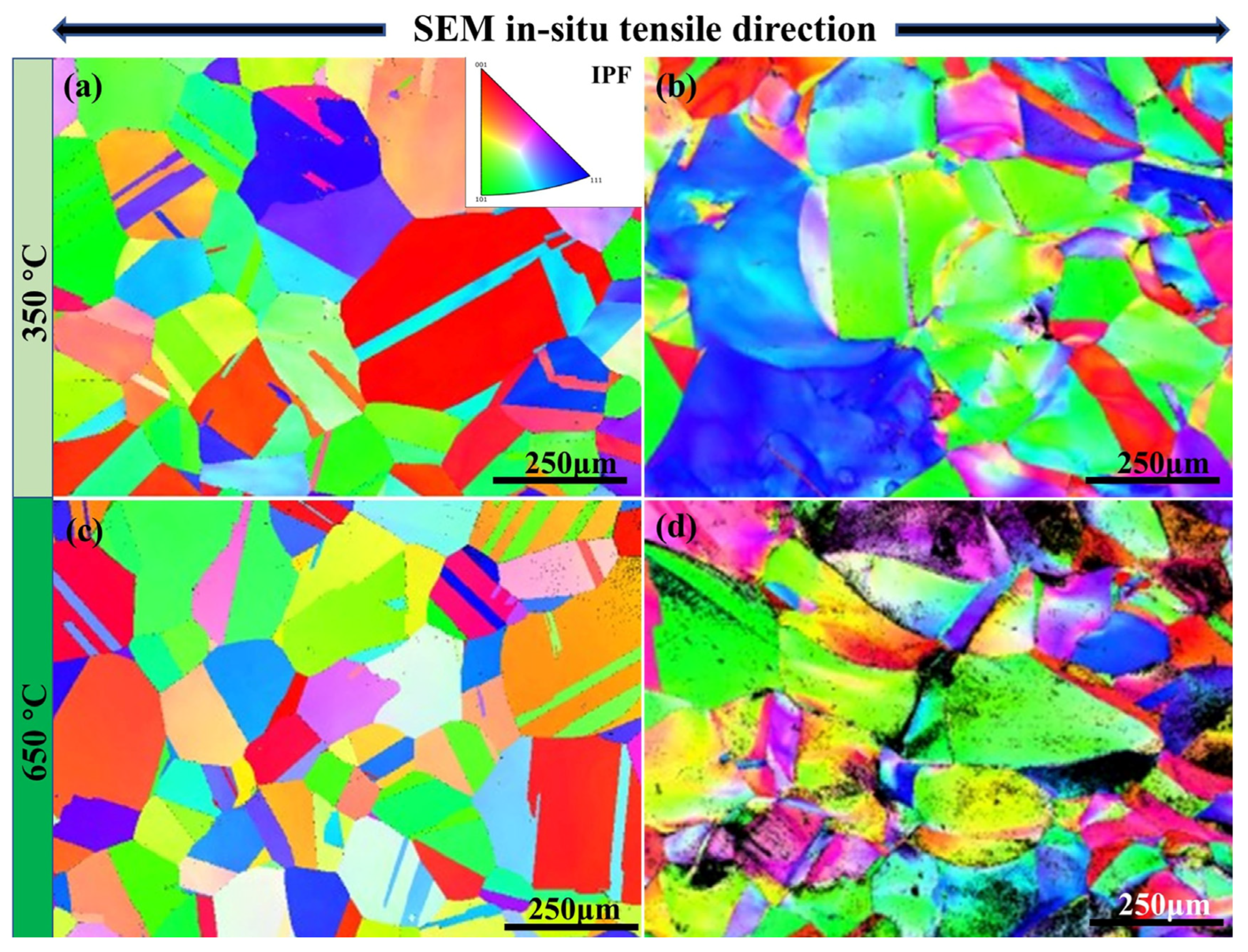

| Experimental Steel | Cr | Ni | Nb | Al | Si | C |
|---|---|---|---|---|---|---|
| S35140 | 20.0~22.0 | 25.0~27.0 | 0.25~0.75 | - | 0.75 | 0.1 |
| N-S35140 | 19.59 | 24.2 | 0.77 | 0.02 | 0.40 | 0.03 |
| Experimental Steel | Mo | N | Ti | Mn | Fe | |
| S35140 | 1.0~2.0 | 0.08~0.20 | - | 1.0~3.0 | Bal. | |
| N-S35140 | 1.69 | 0.1 | 0.04 | - | Bal. |
| Testing Temp. (°C) | Average Dimple Diameter | Areal Density of Dimple (×1011/m2) |
|---|---|---|
| TR | 540 nm | 12.2 |
| 350 | 695 nm | 4.05 |
| 650 | 899 nm | 3.15 |
Disclaimer/Publisher’s Note: The statements, opinions and data contained in all publications are solely those of the individual author(s) and contributor(s) and not of MDPI and/or the editor(s). MDPI and/or the editor(s) disclaim responsibility for any injury to people or property resulting from any ideas, methods, instructions or products referred to in the content. |
© 2025 by the authors. Licensee MDPI, Basel, Switzerland. This article is an open access article distributed under the terms and conditions of the Creative Commons Attribution (CC BY) license (https://creativecommons.org/licenses/by/4.0/).
Share and Cite
Lei, P.; Ji, X.; Chen, J.; Huang, Y.; Lv, N.; Fan, Y.; Hou, Y.; Shi, X.; Yun, D. A Study on the Microstructure and Mechanical Properties of Improved 25Ni-20Cr Steel via in Situ Testing. Nanomaterials 2025, 15, 413. https://doi.org/10.3390/nano15060413
Lei P, Ji X, Chen J, Huang Y, Lv N, Fan Y, Hou Y, Shi X, Yun D. A Study on the Microstructure and Mechanical Properties of Improved 25Ni-20Cr Steel via in Situ Testing. Nanomaterials. 2025; 15(6):413. https://doi.org/10.3390/nano15060413
Chicago/Turabian StyleLei, Penghui, Xiaoyu Ji, Jiahao Chen, Yunhao Huang, Nan Lv, Yulin Fan, Yongchao Hou, Xinsheng Shi, and Di Yun. 2025. "A Study on the Microstructure and Mechanical Properties of Improved 25Ni-20Cr Steel via in Situ Testing" Nanomaterials 15, no. 6: 413. https://doi.org/10.3390/nano15060413
APA StyleLei, P., Ji, X., Chen, J., Huang, Y., Lv, N., Fan, Y., Hou, Y., Shi, X., & Yun, D. (2025). A Study on the Microstructure and Mechanical Properties of Improved 25Ni-20Cr Steel via in Situ Testing. Nanomaterials, 15(6), 413. https://doi.org/10.3390/nano15060413






